Public-Private Partnerships: A Path to Success
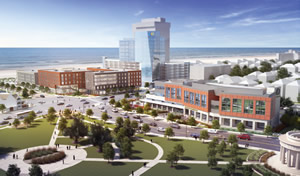
RENDERING COURTESY OF STOCKTON UNIVERSITY
Getting the most out of capital projects requires, among other things, great attention to the details, strategic thinking, cultivating stakeholder buy-in, working closely with local communities, and finding and forging the right partnerships and funding formulas. It also takes bold vision and the ability to think big and persevere.
Two growing institutions in southern New Jersey, Stockton and Rowan universities, are examples.
A Win in Atlantic City
At Stockton University, a recent visit to the site of a 533-bed student residence showed bustling construction just yards from the storied Atlantic City boardwalk. The $93-million building is part of a $200 million initiative that Stockton is implementing, after various fits and starts over the years, to create an Atlantic City campus some 13 miles from Stockton’s main campus in Galloway Township.
Slated to open in 2018, the Atlantic City Gateway residential campus signals a determination to get the very most out of a project for a growing university and a transitioning city. Stockton officials are creating not only a residential campus that will offer new academic facilities and an attractive beachfront housing option for students, but also, as the Atlantic City campus’ Chief Operating Officer Brian Jackson, says, “an impetus for private development to find its way back into” the storied but financially troubled resort community.
The locale is compelling enough for Stockton to unmoor this, a major project, from its growing, crowded main campus. Granted, Stockton was founded in and has had a presence in Atlantic City for years, and offers classes and housing in other locations, Jackson points out.
Funding A New Campus
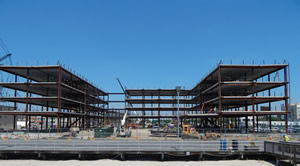
PHOTO © SCOTT BERMAN
The new campus initially will consist of the student residence with three retail stores on its ground floor—retail, possibly including a coffee shop, will help offset construction costs, Jackson says—a $35 million academic building across the street, and a $35 million parking garage beneath utility company offices atop it. Overall, the city’s boardwalk attracts 20,000,000 visitors annually, or an average of almost 55,000 each day, which could contribute significantly to traffic in the development’s retail stores. Ancillary development around the campus will likely add to that traffic.
The project is a public-private partnership (PPP) between Stockton and a non-profit redevelopment company, Atlantic City Development Corporation. The funding mix is as creative as it is complex, and includes $50.6 million in Atlantic County Improvement Authority bonds “secured by almost $70 million in tax revenues” from the state; $77.2 million in county lease revenue bonds “payable by the university,” and a $22 million state higher education capital improvement grant, according to Stockton. Another $8.3 million is coming from a utility company, which is constructing offices atop a university parking garage that is swiftly taking shape.
There is also $18 million in Stockton funds. The money comes from the proceeds of a sale of a shuttered Atlantic City casino building that Stockton had bought, in a plan later discarded due to use restrictions, with the intention of converting it into a 4,000-student high-rise campus. However, the reversal—and reported attempts at acquiring land in the city over the years—didn’t stop various entities from remaining open to new possibilities. Such was the case when the final plan was put together, with Brian Kowalski, Stockton’s interim general counsel, crediting the cooperative efforts of Stockton University; AC Deco; and the state, county, and Atlantic City governments.
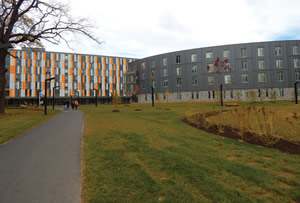
PHOTO © SCOTT BERMAN
The approach may be of interest. Kowalski says it is important to weigh certain things when hammering out financial packages for projects, such as “the cost (interest rate) and terms of any borrower funds to finance the project; the projected revenues generated by or resulting from the project, such as student housing revenues or revenues from increased enrollment that will be applied to the repayment of borrowed funds; and any creative financial options, such as a PPP or tax credits, that might support some portion of the cost of the project.”
Officials are encouraged, and there seems to be a sense of energy across campus. Jackson pointed out during the run-up to the fall 2017 semester that Stockton was expecting its largest freshman class in its history, and that enrollment deposits were up some 50 percent from 2016.
Growing With a Goal
Rowan University, another growing institution in southern New Jersey, is an additional case in point. Located in Glassboro, a community of 19,000, the university has added at least 6,000 students within the past several years, making for an undergraduate-graduate population of about 18,000. The goal, Rowan spokesman Joe Cardona pointed out in a 2016 interview, is 25,000 by 2023, including graduate and remote students; the university’s 100th anniversary.
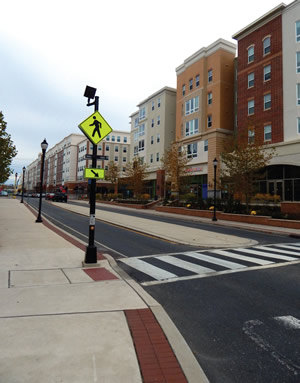
PHOTO © SCOTT BERMAN
WELCOME TO THE NEIGHBORHOOD. Unique in New Jersey, the $350 million Rowan Boulevard redevelopment project linking New Jersey’s Rowan University with Glassboro, NJ’s downtown retail district is redefining both the campus and the borough. The privately funded partnership between the university, developers, and the Borough of Glassboro has a singular goal: to create a quintessential college town. The one-third mile corridor is lined with shops, restaurants, and medical providers at street level with housing, offices, and classrooms on the floors above. Key anchors include the Rowan Boulevard Apartments complex for students, a Barnes & Noble collegiate superstore, and a Courtyard by Marriott hotel and conference center.
Accordingly, the university is deep into an assertive, 20-year program that has included, among other changes, new engineering and business buildings, an expanded recreational center, renovations across campus, and the acquisition and development of a 600-acre parcel called West Campus, 1.5 miles from the main campus. According to Rowan, all athletic facilities may eventually be housed at West Campus, opening up space for more university buildings at the main campus.
Closer to campus, the centerpiece of the efforts by developers is Rowan Boulevard, a $400-million revitalization project. The goal, according to Glassboro, is to link the campus “with the borough’s downtown retail district, creating the quintessential college town,” through a strategy of “smart growth living with mixed-use buildings” with residents and retail. The move is generating tax revenues and jobs, according to the borough.
Growth continues. Two major campus buildings were completed in 2015 and 2016, and in August 2017 three Rowan Boulevard buildings opened—featuring classrooms, retail, apartments, and parking—with an additional residential and retail phase reportedly in the works.
Today, Rowan Boulevard, which erases what was the street grid of a residential neighborhood, includes high-rise student and other residences and office space with retail storefronts below, a large standalone college bookstore, eateries, a large car parking structure, and a hotel.
At one end of the boulevard stands the $145-million Holly Pointe Commons, opened in fall 2016 and, at 303,000 square feet, the largest building on campus. Owned by Rowan, the residence was its first PPP development, with the university teaming up with a branch of The Michaels Corporation and a subsidiary of Provident Resources Group, Inc. Philadelphia’s Erdy McHenry Architecture designed the building, and Torcon, Inc. was the construction manager.
The boulevard projects respond to Rowan’s enrollment goals and the resulting housing demand. For example, two of the apartment complexes are run like others on the nearby campus, with students away for the summer, and a third residence is privately operated affiliated housing. Those options, along with Holly Pointe Commons, which is operated as a traditional residence hall, present a range of housing stock and rent levels for students—a diversified mix of price points.
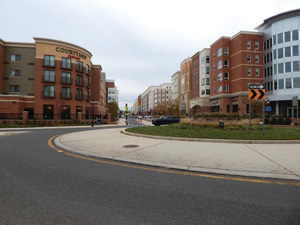
PHOTO © SCOTT BERMAN
A Recipe for Success
Thus, the universities are using various methods to get the biggest bang out of development projects, meeting large goals for advancing institutions and generating new life and value to surrounding communities.
Back at Stockton in Atlantic City, for example, Jackson notes that nearby properties have been bought and renovated, and there are housing and retail projects underway: welcoming signs for the neighborhood and the new campus. In terms of the partnership that enabled the campus, he says in retrospect that “it was a complicated deal to put together,” but the PPP “really opened the door for us to do this, and to do it on the scale we’re able to.”
This article originally appeared in the College Planning & Management January 2018 issue of Spaces4Learning.